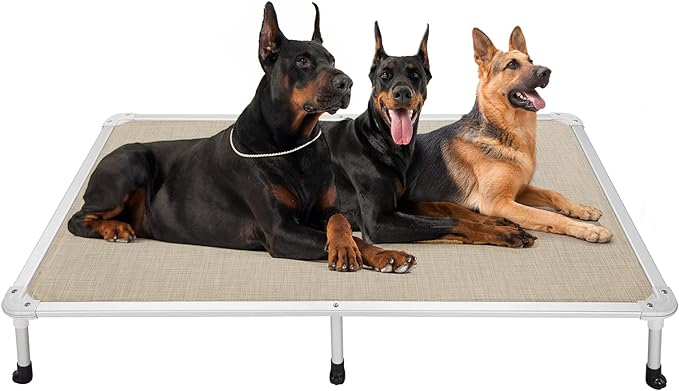Elevated dog bed, also known as raised dog bed, is a popular choice among pet owners due to their comfort and hygiene benefits.
However, to ensure these beds continue to provide a comfortable and safe spot for your furry friend, it’s essential to know how to clean them without damaging their structure.
In this comprehensive guide, we’ll explore the measures you can take to avoid harming the integrity of your elevated dog bed while keeping it clean and inviting.
Understanding the importance of maintenance
Before diving into the specifics of maintaining your elevated dog bed’s structure, let’s emphasize why it’s essential to do so.
These beds offer numerous advantages, including better airflow, orthopedic support, and ease of cleaning. Preserving their structure ensures your pet continues to enjoy these benefits without discomfort or safety concerns.
Benefits of elevated dog beds
Elevated dog beds are beloved by pet owners for several compelling reasons:
- Improved Airflow: The raised design allows air to circulate freely, keeping your dog cool in warm weather.
- Orthopedic Support: Elevated beds provide even support, reducing strain on your dog’s joints and muscles, making them ideal for dogs with mobility issues.
- Hygiene: Unlike traditional beds, elevated beds are less likely to accumulate dirt, dust, and allergens, contributing to better hygiene.
- Durability: These beds are typically made from sturdy materials, ensuring they can withstand the test of time.
Now that we’ve highlighted the benefits, let’s delve into the steps you can take to preserve your elevated dog bed’s structure.

Measures to safeguard your elevated dog bed
Now, let’s explore the key steps you can take to avoid damaging the structure of your elevated dog bed:
Regular inspections
- Inspecting for Stability: Begin by regularly checking the bed’s frame for stability. Over time, screws and joints may become loose. Tighten any loose screws and ensure all connections are secure. Loose parts can lead to wobbling and, ultimately, structural damage.
- Creating a Maintenance Schedule: Establishing a routine for bed inspections can be beneficial. Consider inspecting the bed once a month or as often as needed based on your pet’s behavior and the bed’s usage. This regular checkup can help you identify and address potential issues before they become more significant problems.
Maintain the weight limit
- Understanding Weight Limits: Every elevated dog bed comes with a specified weight limit set by the manufacturer. It’s crucial to respect this limit to prevent structural damage. Exceeding the recommended weight capacity can strain the frame, leading to potential breakage or deformation.
- Choosing the Right Bed Size: Selecting the appropriate bed size for your dog is equally important. Ensure the bed is large enough to comfortably accommodate your pet without exceeding its weight limit. If you have multiple pets sharing the same bed, consider upgrading to a larger size or providing separate beds to prevent overloading.
Provide chew toys
- Distract from Destructive Behavior: Some dogs have a natural inclination to chew on various objects, including their beds. To prevent them from damaging the bed’s frame, provide appropriate chew toys. This not only keeps them occupied but also redirects their chewing instincts away from the bed.
- Selecting Durable Toys: When choosing chew toys, opt for those specifically designed for durability. Look for toys made from tough materials that can withstand vigorous chewing. Additionally, inspect the toys regularly for signs of wear and replace them as needed to ensure they remain effective distractions.
Training your pet
- Positive Reinforcement Techniques: Train your pet to avoid destructive behavior by using positive reinforcement techniques. Reward them when they behave well around the bed and provide gentle correction when they attempt to chew or scratch it. Consistency in training is key to preserving the bed’s structure.
- Consulting a Professional Trainer:If your pet’s behavior proves challenging to address on your own, consider seeking the help of a professional dog trainer. They can provide personalized guidance and training plans tailored to your pet’s specific needs.
Optimal placement
- Choosing the Right Location: Consider where you place the elevated dog bed. Avoid positioning it near sharp objects, such as furniture with protruding edges, that could inadvertently cause damage to the bed’s frame. A safe location can prevent accidents and preserve the bed’s structure.
- Monitoring Pet Behavior: Pay attention to your pet’s behavior around the bed’s placement. If you notice any potentially harmful interactions or behaviors, such as excessive scratching or chewing on nearby objects, consider relocating the bed to a more suitable spot.

Advanced maintenance tips
In addition to the fundamental measures mentioned above, there are advanced techniques you can employ to ensure your elevated dog bed remains in excellent condition for an extended period:
Protective covers
- Using Protective Covers: Consider investing in protective covers designed specifically for elevated dog beds. These covers are often made from durable materials that can withstand scratching and chewing. They act as an extra layer of defense against potential damage to the bed’s frame.
- Variety of Protective Covers: Protective covers come in various materials, including waterproof options that protect against accidents and spills. Some covers are even designed to provide additional comfort and support to your pet.

Periodic deep cleaning
- Thorough Cleaning Routine: While regular maintenance involves spot cleaning, it’s also essential to perform periodic deep cleaning of the entire bed. Follow the manufacturer’s instructions for disassembling the bed, if applicable, and clean all components thoroughly. Deep cleaning helps remove accumulated dirt, allergens, and odors.
- Cleaning the Fabric: The fabric or mesh surface of the bed can trap dirt and odors over time. It’s essential to wash or clean this part of the bed regularly to maintain hygiene and ensure your pet’s comfort.
Replacement parts
- Availability of Replacement Parts: Check with the bed’s manufacturer to inquire about the availability of replacement parts. This can be particularly useful if you ever need to replace specific components, such as screws, legs, or fabric. Having access to replacement parts ensures that you can address issues promptly without having to replace the entire bed.
- Extended Warranty Options: Some manufacturers offer extended warranty options that cover not only the bed but also replacement parts. These warranties can provide peace of mind and financial protection in case of unexpected structural issues.
Conclusion
In conclusion, maintaining the structure of your elevated dog bed is essential to ensure it continues to provide comfort and support to your furry companion.
By regularly inspecting the bed for stability, respecting weight limits, providing chew toys, and implementing positive reinforcement training, you can extend the life of your pet’s bed and keep it in excellent condition.
Remember that a well-maintained elevated dog bed not only benefits your pet but also enhances the overall hygiene of your home.
So, keep these measures in mind as you care for your beloved pet and their elevated dog bed. With proper maintenance, your pet can enjoy a comfortable and structurally sound bed for years to come.
By following advanced maintenance tips such as using protective covers, periodic deep cleaning, and keeping an eye out for replacement parts, you can go the extra mile in ensuring the longevity of your pet’s bed.
So, go ahead and give your furry friend the gift of a comfortable and durable elevated dog bed that will keep them happy and healthy.
Remember that a well-maintained elevated dog bed not only benefits your pet but also enhances the overall hygiene of your home.
So, keep these measures in mind as you care for your beloved pet and their elevated dog bed. With proper maintenance, your pet can enjoy a comfortable and structurally sound bed for years to come.













